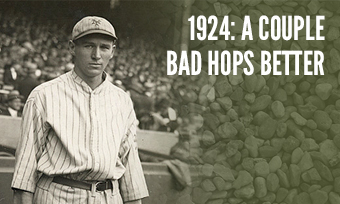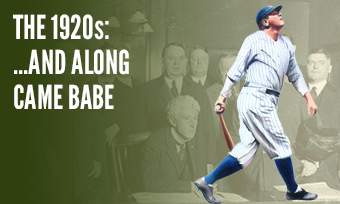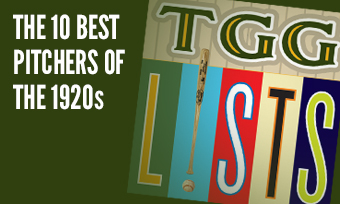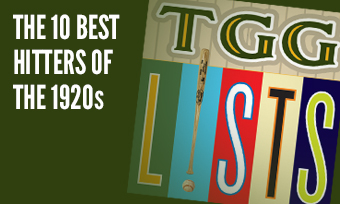The Yearly Reader
Leaders and Honors, 1924
Our list of baseball’s top 10 hitters and pitchers in both the American League and National League for the 1924 baseball season, as well as the awards and honors given to the game’s top achievers of the year.
The National League’s Top 10 Hitters, 1924
Bold type in brick red indicates league leader.
1. Rogers Hornsby, St. Louis
Key Numbers: 143 games, .424 average, 121 runs, 227 hits, 43 doubles, 14 triples, 25 home runs, 94 RBIs, 89 walks, .507 on-base percentage, .696 slugging percentage.
Batting .424 is tough enough, but Hornsby had to do it for part of the year with a dislocated thumb.
2. Jack Fournier, Brooklyn
Key Numbers: 154 games, .334 average, 93 runs, 188 hits, 27 home runs, 116 RBIs, 83 walks.
Among Fournier’s collection of hits was eight of 27 home runs against the Giants (who finished just a game ahead of the Robins) and one against a bystander who somehow upset the irritable first baseman at an establishment. (Fournier paid $25 in court to settle the case.)
3. George Kelly, New York
Key Numbers: .324 average, 91 runs, 185 hits, 37 doubles, 9 triples, 21 home runs, 136 RBIs.
Kelly’s 136 RBI led the majors—yes, that includes Babe Ruth—and also evoked the Bambino by hitting seven HRs in a six-game stretch in June.
4. Zack Wheat, Brooklyn
Key Numbers: .375 average, 92 runs, 212 hits, 41 doubles, 8 triples, 14 home runs, 97 RBIs.
After hitting .375 the year before—but not qualifying for the batting title because he only played in 98 games—Wheat did it again with plenty of at-bats and set a personal best in the meantime.
5. Ross Youngs, New York
Key Numbers: .356 average, 112 runs, 187 hits, 33 doubles, 12 triples, 10 home runs, 74 RBIs, 77 walks.
Certainly the most productive set of numbers for the 27-year-old outfielder—a circumstance all the more painful given he would begin his downfall a year later from Bright’s Disease, which would claim his life in 1927.
6. Kiki Cuyler, Pittsburgh
Key Numbers: 117 games, .354 average, 94 runs, 27 doubles, 16 triples, 9 home runs, 85 RBIs, 32 stolen bases.
The five-tool talent rose to stardom in his rookie year, flirting with .400 until enduring a September slump.
7. Cy Williams, Philadelphia
Key Numbers: .328 average, 101 runs, 183 hits, 31 doubles, 11 triples, 24 home runs, 93 RBIs, 67 walks.
Infielders stacked up to the right of second base, creating the Williams Shift—not for Ted, but dead-pull slugger Cy.
8. Frankie Frisch, New York
Key Numbers: .328 average, 121 runs, 198 hits, 33 doubles, 15 triples, 7 home runs, 69 RBIs, 22 stolen bases.
Another banner year for the Fordham Flash included the lone six-hit game of his career.
9. Jim Bottomley, St. Louis
Key Numbers: .316 average, 87 runs, 167 hits, 31 doubles, 12 triples, 14 home runs, 111 RBIs.
Bottomley’s average dropped from his .371 effort a year before, but he made up by producing stronger power numbers.
10. Max Carey, Pittsburgh
Key Numbers: .297 average, 113 runs, 178 hits, 30 doubles, 9 triples, 58 walks, 49 stolen bases.
Ate age 35, Carey still showed they had plenty of juice in his aging legs, once again leading the leagues in steals.
The American League’s Top 10 Hitters, 1924
1. Babe Ruth, New York
Key Numbers: .378 average, 143 runs, 200 hits, 39 doubles, 7 triples, 46 home runs, 121 RBIs, 142 walks, 81 strikeouts, .513 on-base percentage, .739 slugging percentage.
The Sultan of Swat maintained his usual power surge while winning his only AL batting crown.
2. Harry Heilmann, Detroit
Key Numbers: .346 average, 107 runs, 197 hits, 45 doubles, 16 triples, 10 home runs, 114 RBIs, 78 walks.
An even year meant no batting title for Heilmann (see 1921, 1923, 1925 and 1927), but that hardly pacified opposing pitchers who still dreaded facing him.
3. Goose Goslin, Washington
Key Numbers: .344 average, 100 runs, 199 hits, 30 doubles, 17 triples, 12 home runs, 129 RBIs, 68 walks, 15 stolen bases.
At 23, Goslin emerged as a big-time star in D.C., collecting more than half of the Senators’ home runs—including the only one hit by a Washington Senator at voluminous Griffith Stadium all year long.
4. Eddie Collins, Chicago
Key Numbers: .349 average, 108 runs, 194 hits, 6 home runs, 86 RBIs, 89 walks, 42 stolen bases.
See Max Carey (above), with this added note: Collins won his stole base title at age 37.
5. Bob Meusel, New York
Key Numbers: .325 average, 93 runs, 188 hits, 40 doubles, 11 triples, 12 home runs, 120 RBIs, 26 stolen bases.
Bob out-RBI’d brother Irish (who had 102 for the Giants) after surviving an off-season car crash in San Diego which killed Boston Braves third baseman Tony Boeckel, and an all-out riot he helped instigate at Detroit between the Yankees and Tigers in June.
6. Ken Williams, St. Louis
Key Numbers: 114 games, .324 average, 18 home runs, 84 RBIs, 69 walks, 20 stolen bases.
Emblematic of the Browns’ health issues in 1924, Williams suffered from a broken foot in midsummer that muted what otherwise might had been another full season of stellar numbers.
7. Ty Cobb, Detroit
Key Numbers: .338 average, 115 runs, 211 hits, 38 doubles, 10 triples, 4 home runs, 78 RBIs, 85 walks, 23 stolen bases.
Continuing on the theme of old stars maintaining a strong spring in their step, the 37-year-old Cobb swiped 23 bases after pilfering nine in each of his previous two seasons.
8. Joe Hauser, Philadelphia
Key Numbers: .288 average, 97 runs, 31 doubles, 8 triples, 27 home runs, 115 RBIs.
Hauser had his best year in the majors; a leg injury would later limit him to minor league play where, in 1933, he would hit a monstrous 69 homers at Minneapolis.
9. Sam Rice, Washington
Key Numbers: .334 average, 646 at-bats, 106 runs, 216 hits, 39 doubles, 14 triples, 76 RBIs, 24 stolen bases.
The all-time hit leader for the Senators/Twins franchise collected over 200 for the first of three straight seasons—and the second of six such campaigns for his career.
10. George Sisler, St. Louis
Key Numbers: .318 average, 103 runs, 184 hits, 41 doubles, 12 triples, 19 home runs, 97 RBIs.
After missing all of 1923, Sisler provided a modest comeback by his standards, given that he was last seen hitting .420 in 1922.
The National League’s Top 10 Pitchers, 1924
1. Dazzy Vance, Brooklyn
Key Numbers: 2.16 ERA, 28 wins, 6 losses, 30 complete games, .824 win percentage, 308.1 innings, 262 strikeouts.
The dominant Vance struck out the most batters in the NL between Christy Mathewson (1903) and Sandy Koufax (1961).
2. Eppa Rixey, Cincinnati
Key Numbers: 2.76 ERA, 15 wins, 14 losses, 4 shutouts.
A late (and not very good) start to the year kept Rixey from throwing over 300 innings for the first time in four seasons, but he rebounded well even if the win-loss record didn’t quite reflect it.
3. Carl Mays, Cincinnati
Key Numbers: 3.15 ERA, 20 wins 9 losses, 226 innings, 36 walks.
Only a combination of pitching brilliance and an outright crabby attitude would allow Mays (now with the Reds) to be a 20-game winner for three different teams.
4. Ray Kremer, Pittsburgh
Key Numbers: 3.19 ERA, 18 wins, 10 losses, 41 appearances, 4 shutouts, 259.1 innings.
Better late than never, the 31-year-old “rookie” showed veteran sage after years of starring in the Pacific Coast League.
5. Emil Yde, Pittsburgh
Key Numbers: 2.83 ERA, 16 wins, 3 losses, .842 win percentage, 4 shutouts.
To answer your first question: The last name is pronounced, “Eddy.” As to the second question, which usually is, “Who the hell is Emil Yde?” He was a 24-year-old rookie who won his first eight decisions before a slight drop-off in the year’s second half; the slide would turn deeper in the years to follow before bowing out of the majors shy of turning 30.
6. Burleigh Grimes, Brooklyn
Key Numbers: 3.82 ERA, 22 wins, 13 losses, 36 starts, 30 complete games, 310.2 innings.
Nobody in the NL allowed more hits and runs—but no one else threw more innings, faced more batters and completed more games than the resilient, legal spitballer who won 20-plus games for the fourth time.
7. Wilbur Cooper, Pittsburgh
Key Numbers: 3.28 ERA, 20 wins, 14 losses, 4 shutouts, 268.2 innings.
The Pirates ace was one of three on the staff to co-lead the NL with four shutouts; sadly, it was his last go-around as he was dealt to the Cubs for 1925 and missed out on a Pirates’ world title.
8. Rube Benton, Cincinnati
Key Numbers: 2.77 ERA, 7 wins, 9 losses, 162.2 innings, 24 walks.
In his second year back with Cincinnati after pitching there during the early 1910s, Benton authored one of his best ERAs in spite of an anonymous record; he was just happy to still be able to pitch in the majors despite confessing to second-hand knowledge of the Black Sox Scandal as it happened.
9. Hugh McQuillan, New York
Key Numbers: 2.69 ERA, 14 wins, 8 losses.
Typically a good but not great pitcher on a good but not great Giants staff, McQuillan posted the best ERA of any New York starter.
10. Virgil Barnes, New York
Key Numbers: 3.06 ERA, 16 wins, 10 losses, 229.1 innings.
After two years as a pure reliever for the Giants, Barnes finished behind McQuillan on ERA rank and also was the sole Giant to throw over 200 innings—a rarity, even in live ball times, for a pennant winner.
The American League’s Top 10 Pitchers, 1924
1. Walter Johnson, Washington
Key Numbers: 2.72 ERA, 23 wins, 7 losses, .767 win percentage, 38 starts, 6 shutouts, 277.2 innings, 158 strikeouts.
The Big Train’s renaissance campaign not only brought him his lone championship, but his 12th and last AL strikeout title.
2. Herb Pennock, New York
Key Numbers: 2.83 ERA, 21 wins, 9 losses, .700 win percentage, 286.1 innings.
Happy to be a Yankee: Pennock performed the part of workhorse more than any other season and ran his two-year record at New York to 40-15 after going 23-31 over the two years before that with the disassembling Red Sox.
3. Tom Zachary, Washington
Key Numbers: 2.75 ERA, 15 wins, 9 losses.
The southpaw from North Carolina continued a career arc that kept ping-ponging north and south—going northward this year with a career-low ERA.
4. Howard Ehmke, Boston
Key Numbers: 3.46 ERA, 19 wins, 17 losses, 45 appearances, 36 starts, 315 innings.
The veteran junkballer continued to eat up innings, but life on the depleted Red Sox was beginning to eat him up; he would drop to 9-20 the following year and sent out an SOS that would be answered by a much better team (the A’s, who picked him up in 1926).
5. Rip Collins, Detroit
Key Numbers: 3.21 ERA, 14 wins, 7 losses.
Collins rebounded from an injury-riddled 1923 (3-7, 4.87 ERA in 17 appearances).
6. Sherry Smith, Cleveland
Key Numbers: 3.02 ERA, 12 wins, 14 losses, 247.2 innings, 42 walks.
Life is not fair: Smith’s ERA was a bit healthier than teammate Shaute—who somehow won eight more games.
7. Firpo Marberry, Washington
Key Numbers: 3.09 ERA, 11 wins, 12 losses, 15 saves, 50 appearances, 14 starts.
In his first full season, the 25-year old Marberry developed into an unusual specimen among pitchers: A relief specialist.
8. Joe Shaute, Cleveland
Key Numbers: 3.75 ERA, 20 wins, 17 losses, 46 appearances, 283 innings.
No lefty lost more games, but only Herb Pennock (above) won more than the Indians’ one-year workhorse.
9. Sloppy Thurston, Cleveland
Key Numbers: 3.80 ERA, 20 wins, 14 losses, 28 complete games, 291 innings.
With Red Faber starting to rust and Ted Lyons not yet fully flowered, Thurston filled in as the temporary White Sox ace.
10. Eddie Rommel, Philadelphia
Key Numbers: 3.95 ERA, 18 wins, 15 losses, 43 appearances, 278 innings.
Statistical oddity: Rommel was 9-5 with a 2.46 ERA against the AL’s three best teams (Senators, Yankees and Tigers)—and 9-10 with a 5.15 mark against the other four.









